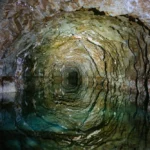Energy News Beat
One of the biggest challenges with heating homes from renewable sources is the reliability of energy supplies during different seasons and types of weather – yet geothermal heat has much to offer.
The main misconception about geothermal heat is that it is reliant on steam rising from geysers as famously seen in Iceland. In fact, there are three main sources of geothermal heat – hot rocks, heat from aquifers, and heat from water in abandoned mines. It is heat from mine water that holds significant potential in Scotland.
Much progress is being made in the roll-out of heat pumps and scale-up of heat networks to decarbonise heating, but the vast potential of geothermal mine water remains relatively untapped. To harness the dormant assets of flooded mines throughout Scotland, considerable research is under way – along with some hugely promising demonstrator projects.
Harnessing geothermal heat sources in Scotland
The mines that were once the heartbeat of UK communities could soon make a major contribution to the energy transition through geothermal heat, as well as regenerating industries in towns that may not been present since the mines closed.
In Scotland, there is a potential 600km3 of disused mineworkings available in the Midland Valley. This could theoretically meet 8% of Scotland’s domestic heating requirements and up to 40% of Glasgow’s heat demand. If this potential is realised, it could make Scotland a world leader in the sector.
Research by the UK Coal Authority suggests that these flooded shafts could hold 7,920 petajoules of untapped heat. For context, natural gas was used to produce 1,080 petajoules to heat UK homes in 2020, according to UK Government data.
Shallow mines with depths down to 200m typically have water temperatures of 10˚C–25˚C. To use this in a heat network, a borehole is used to access mine water. A heat pump then extracts the heat and boosts it to the required temperature. Hot water is then circulated to household or business customers for heating, while another loop carries cold water back to the source for reheating.
Using mine water for geothermal energy storage
Flooded mines could also be used to store thermal energy. A persistent issue with wind energy is turning the turbines off when the generation capacity peak is reached. Researchers believe that in East Ayrshire, an estimated 120GW is effectively going to waste from unused wind.
To address this, the STEaM thermal storage project aims to use mine water to thermally store excess wind energy. Described as a giant immersion heater, the project team believe it is possible to establish high-volume storage of thermal energy that is consistent year-round, regardless of the season or weather.
Professor Zoe Shipton from the University of Strathclyde leads the STEaM thermal storage project. Shipton also led the HotScot project, bringing together academics, local government, industry and the social sector to establish Scotland’s abandoned mines as assets.
“We have got holes in the ground. They are big and underneath cities. The question with STEaM is if we fill them with heat and then take it out again multiple times a year, can we do that safely and effectively?” says Shipton.
“We think we can, but we need to do the research to investigate that. STEaM is a research project, but the results should unlock a really exciting opportunity, not just for Scotland but globally.”
Geothermal storage potential in Scotland
In the UK, there are 177,000 known mine entries. It is not yet known what proportion of these are suitable for storage. Older, shallower shafts are typically lined with brick or wood, with the newer shafts deeper and generally lined by concrete. STEaM is undertaking assessments to determine the structural integrity of these mine shafts under cycles of temperature.
However, if only 1% of these mine entries were capable of holding 20,000m3 of water, Shipton suggests that they could store 1,900GW-hours of thermal energy from curtailed wind. This would be enough to provide heating for 2.8 million, or 10%, of UK homes during a worst-case weather week with plunging temperatures and no wind.
Much more research is required to prove these projections in real-world settings. The goal of the project is to see if water temperatures of 55°C can be reached and safely sustained in mine water. If this is possible, researchers predict that the storage site can connect to a heat network without the need to boost the water temperature from heat pumps. Importantly, this would reduce the electrical load from the grid, contributing to grid stability during times of high demand for electricity for heating elsewhere – such as heat pumps in homes.
Studies of thermal storage in mine workings in Europe are in their early stages and small in scale. STEaM is the first project to explore storage within a shaft rather than lower-volume mineworkings.
Nevertheless, the STEaM team is committed to understanding the safe operating temperatures and avoiding chemical reactions that could potentially negatively impact the environment or the wider heat network.
The plan is to start experiments at a physical site in 2024, continuing into 2025. The team is analysing water chemistry and taking temperature samples to characterise the water and determine the baseline. Detailed analysis will be completed during and after heat injection to assess the effect of heating and cooling cycles on the water body.
Energy from wind turbines in Scotland could be stored underground in mine water.
Reusing heat from the dancefloor
To fully harness the potential of geothermal energy, a range of different innovative projects are under way in Scotland. Perhaps the most eye-catching project is the BODYHEAT system, which stores heat from people dancing in the SWG3 nightclub in Glasgow. Developed by Scottish geothermal start-up TownRock Energy, heat pumps powered by renewable energy extract heat from the dancefloor and send it for storage in 12 U-shaped boreholes that are 200m underground.
When the energy is needed for heating or cooling, heat is pumped back up to the heat pumps and upgraded to the correct temperature before reuse. The system can even capture heat and use it for cooling during the same event. The project was developed with funding and support from the Scottish Government, the UK Community Renewal Fund and the William Grant Foundation.
“BODYHEAT at SWG3 is a world first – quick response borehole thermal energy storage for a multi-use arts venue across two buildings,” says David Townsend, founder and CEO of TownRock Energy. “We were developing the technology, as well as fundraising and permitting for three years prior to turn-on, nearly entirely during the height of the Covid pandemic.”
According to Townsend, the success of the project has led to global interest in the concept from a range of different businesses.
“TownRock Energy has received an abundance of enquiries from all over the world thanks to the global media attention over the past two years, not just from venues but also from diverse customers such as data centre operators and farmers,” he adds. “We are working on rolling it out, and some of the main challenges include retrofitting existing buildings, permanency of building use and ownership.”
Support for Scottish geothermal projects
Despite the immense potential for geothermal energy, several issues must be resolved before it can be adopted more widely. At present, there remains uncertainty as to who owns geothermal heat. The Scottish Government is ahead of the other nations in drafting legislation for heat, with further clarity surrounding geothermal expected.
To further the understanding of geothermal processes in Scotland, the British Geological Survey’s Glasgow UK Geoenergy Observatory offers essential research capabilities. The site has 12 boreholes equipped with 319 advanced sensors for testing between 16m and 199m deep to study the environmental impact and changes in the chemistry of shallow, low-temperature mine water. Various types of environmental monitoring are available, with open data available for research.
The facility can be used by industry, academia and public sector organisations. Project partnerships are also available. “It is an amazing platform for experimentation, and for validating new products such as sensors,” comments Shipton.
There is also a push in Scotland to make full use of the transferrable skills from the oil and gas industry. Geothermal could benefit greatly from extensive domestic experience in areas such as drilling, corrosion management, underground modelling and data analytics.
A further useful resource is the Mine Water Geothermal Resource Atlas, an online mapping feature that identifies a total of 370.3km2 of sites in Scotland that are potentially suitable for geothermal mine water developments.
Funding for geothermal projects in Scotland
Funding remains one of the main obstacles for geothermal. To address this in Scotland, there are a range of potential grants and other types of financial support available.
Scotland’s Heat Network Fund has a total of £300m ($379.93m) available in capital grants to support heat projects throughout Scotland. All projects must be based in Scotland, of large scale, reduce emissions, and deliver societal and economic benefits.
Furthermore, the Green Heat Innovation Support Programme from Scottish Enterprise has a total pot of £17.6m available from November 2022 to March 2026 to support the roll-out of low-carbon heating solutions, which include geothermal.
Scottish Enterprise can also help companies access funding for green energy projects within Horizon Europe after the UK was recently readmitted.
“If we can sufficiently research those first few projects and allow the academics to get in and pull apart some of the issues and demonstrate things such as how to model where the heat goes, how to monitor the water chemistry and develop mitigation measures for the unlikely event of problems – all of that will really help unlock the potential of the industry,” adds Shipton.
ENB Top News
ENB
Energy Dashboard
ENB Podcast
ENB Substack
The post Going underground: Unlocking the potential of geothermal mine water in Scotland appeared first on Energy News Beat.








